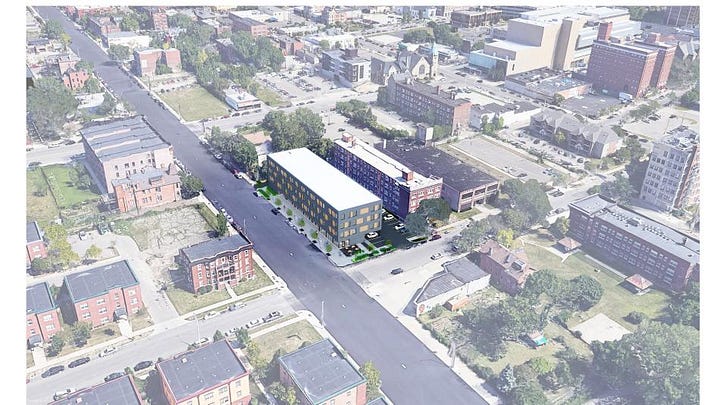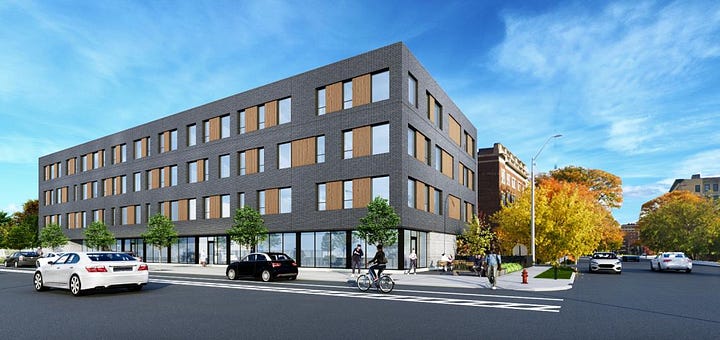It seems a little bit like the whole state goes into a hibernation after Christmas until the first crack of spring. While we had a pretty mild winter, it was still dark and chilly, and the news around the City reflected that. It was a bit slow, maybe a bit dull, but when we finally get those nice days of spring poking through, the development starts to start back up and so does the news.
Landy Land, LLC
Over the last few weeks, details have come out regarding the group that purchased the real estate portfolio formerly owned by Joel Landy. Landy, who passed away in 2020 at the age of 68, was known as an eccentric collector of antiques, an auto mechanic, and eventually a real estate developer. Perhaps his most well-known project was the complete restoration of the James Scott Mansion, which was originally built in 1897 and had fallen into such disrepair over the years it was slated for demolition. After Landy’s death, his entire real estate portfolio was put up for auction, with proceeds funding a foundation to promote automotive education and historic preservation.
After being tied up in probate court for a bit, the sale was final approved and finalized, with the buyer being identified as “Landy Land, LLC”, a joint venture between developer Civic Companies and Kevin Kovachevich, who is credited as founder of commercial real estate financing firm District Capital. Not surprisingly, soon after the sale was finalized, we’ve begun to see movement in renovating and developing the portfolio. Currently, Civic Companies is working on the redevelopment of the Kaul Glove Building and adjacent buildings in Corktown, as well as a new construction condominium project in Woodbridge called The Scripps District.
The first major announcement from the new “Landy Land” group was the proposed construction of a 154 unit apartment complex at the corner of Woodward and Charlotte, wrapping around the Addison Apartments (also owned by Landy Land). The apartment building, aptly named “The Landy”, first appeared on the DEGC Brownfield agenda, indicating the development group will be seeking a brownfield TIF (Tax Incremental Funding). The project will incorporate multilevel parking along Charlotte and retail fronting Woodward. It’s expected the “The Landy” will be complete in 2027.
In addition to the new build, there will be rehab of the buildings to the north along Woodward, directly adjacent to “The Landy”. A rehabilitation proposal for the properties was in front of the Historic District Commission this week. The facade improvements look to restore the cornice on the Wagner Building and install custom awnings across all three buildings. The three buildings currently house a few small businesses and lofts, but all look to be in the need for some rehab.
Landy Land is a new player in the Midtown development game. While Civic Companies has done a few projects around Detroit, they’ve really upped their game with the Towns at Scripps Park and now the Landy, showing they are ready to take on much larger projects. Bringing in District Capital indicates to me that they have the financial resources to get it done and they are already in front of various public bodies to get approvals. This is another great gap fill project on Woodward, along with the recent Woodward West and AC Marriott projects, and includes historic rehab which is always a plus. I’ll be interested to see if there is any activation along the Charlotte side, as the perpendicular streets to Woodward on the west side could use some love. On the downside for the project, most units will have a great window view of a DTE power station across Charlotte. Can’t win them all.
I’m looking forward to not only these projects, but what the future holds for the former Landy portfolio and the new “Landy Land, LLC” that owns at least 50 of them. There are a few more large vacant parcels that I’m sure they are sizing up for potential redevelopments once “The Landy” gets underway.
Credit Upgrade for the City
Last month, it was announced the City’s credit rating had again been increased to investment grade, this time by two notches, Ba1 to Baa2 by Moody’s. Shortly after, S&P followed suit by upgrading Detroit Unlimited Tax General Obligation debt to BBB from BB+ and Priority-Lien debt rating to A- from BBB. This marks a return to investment grade for the City for the first time since 2009, and a great amount of growth since the City declared bankruptcy in 2013. While this seems extremely unexciting in the realm of development, it will likely have extremely positive effects.
A higher credit rating allows the City to sell municipal bonds to a wider range of investors, as well as potentially gain more favorable rates for borrowing. Essentially, the rating signals to investors that Detroit is a safer investment and thus, they do not demand as high of rates as they may if the rating was lower. This will allow the City to borrow using bonds for projects such as parks, libraries, and infrastructure. Borrowing using these municipals bonds serves as a way for the City to take on large up front capital expenditures and repay them over time. Recently, Proposal N was funded through the sale of $250 million in neighborhood improvement bonds, allowing the City to renovate or demolition 16,000 homes. These types of projects would be nearly impossible without the sale of bonds, and now the options for Detroit have grown with their increased credit rating.
State of the Market
I was lucky enough to be able to attend an event last month at the David Whitney hotel pegged as a “State of the Market” from Bisnow and subtitled “Exploring the City’s Resiliency and Regrowth Through CRE Trends”. Much of the conversations revolved around the increased investment in the City and what challenges still persist. There was some interesting talk about how the lower investment within the City over the past decade or so may help the downtown core weather a bit of the storm when it comes to office vacancies, since there wasn’t as much of a buildup. The whole conversations was interesting, and it was great to get different perspectives from different people in different industries.
The most interesting, I thought, and most encouraging, was there are so many companies there who were talking about how they are starting to develop bigger projects, more complicated capital stacks, and venture into new areas of Detroit. For so long, it’s seemed that the Detroit development scene was dominated by a few large players with deep pockets. And maybe that was out of necessity, it’s been tough to get banks to lend in Detroit, especially outside of the downtown area and unless you’re a billionaire and can self-finance projects, you need financial backing. Within the few hour talk and meeting, there were multiple developers who talked about how, over the last few years, they have grown and expanded, now taking on projects of 50+ units, new hotels, and multi-million dollar capital stacks.


While Bedrock and Olympia may be common names, you’ve started to see developers like Method Development expand into downtown with their project at the Merchants Building, Greatwater Opportunity Capital take on new builds in Midtown, and Inkwell Partners rehabbing new blocks of housing in the North End. Some of these new developers were highlighted a bit last year at Detroit Homecoming, and it’s encouraging to see these developers step into bigger and more complicated projects. Development can be and should be done at any size, but at some point, there is a level of complication that limits some developers unless they really want to take on the next step of challenges, and clearly these, and many more, want to take that next step. It’s extremely encouraging to see and it’s great to see so many developers in so many different areas of Detroit. As more and more developers continue to invest in Detroit, you see new sources of capital, new architects, and new contractors experiencing the growth of Detroit first hand, it can have an snowball effect that we’ve already begun to see!






